- Home
- Learn
- Healthcare
- Digital Marketing Strategy for Healthcare: The Essential Checklist
HEALTHCARE
Digital Marketing Strategy for Healthcare: The Essential Checklist
Contents
The top three marketing goals for healthcare organizations are: (1) increase patient volume, (2) build brand awareness, and (3) improve patient loyalty.
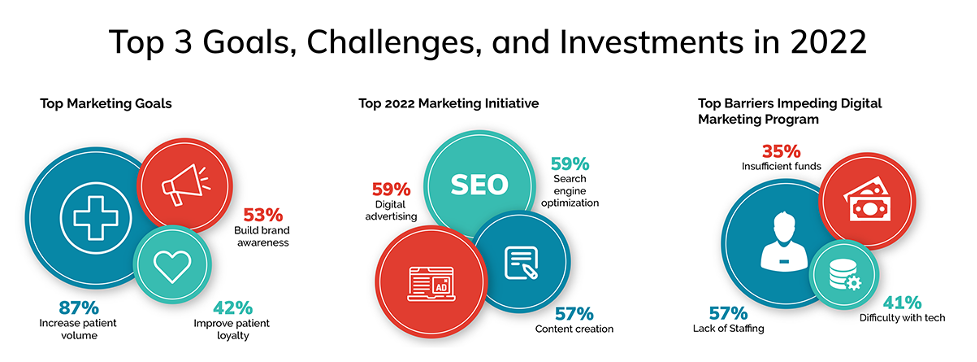
Achieving these goals will require taking a wide-ranging approach to crafting a digital healthcare marketing plan.
In this lengthy article, you’ll find 20 ideas to up your marketing game. Out of respect for your time here and now, it doesn’t dig deep into each one. But if you’re wondering if important elements are missing from your digital marketing strategy and looking to expand your plan, you’re on the right page.
The process of developing effective marketing content begins with understanding who you’re communicating with and how you can help them meet their needs.
Who are your ideal patients? What are their concerns throughout their journey with your practice?
Organizations need to understand the attitudes, values and preferences driving consumers’ decisions about their healthcare.
Source: Huron 2021 Healthcare Executive Researc
The answers should be documented in a series of patient personas you carefully develop to represent segments of best-fit patients. ReferralMD offers the following tips for creating patient personas:
After documenting a persona, your next task is to map the patient’s journey. Doing so should give you insights into how you can tailor messages to best address their needs and optimize the user experience across all touchpoints.
Of course, you can’t pre-build optimized experiences for every individual. Try to make your process for creating personas and mapping messaging to the patient journey as efficient as possible by analyzing data to identify your highest volume journeys.
Your website is the hub for your digital marketing. Assume prospective new patients will spend time on it and optimize it to ensure they have a great experience with your online HQ.
Your website’s content, layout, and navigation are your top priorities. And, of course, your website must shine on mobile devices. Visitors should be able to find the information they seek within a few clicks.
Remember, your organization’s site must comply with all facets of the Health Insurance Portability and Accountability Act (HIPAA).
Patients clearly want to communicate with their healthcare providers online. The U.S chatbot market for healthcare is expected to expand enormously by 2025.
While you can’t take phone calls 24×7, you can answer the basic questions the majority of new patients will ask around the clock with a chatbot. Chatbots not only meet the needs of patients but can give your operation an immense productivity boost.

When a patient searches for a local healthcare provider via Google, they are instantly presented with the top three Google Business Profiles (formerly Google My Business) that match their search criteria. Although a “More places” link expands the results to include many additional practices, it’s obviously beneficial to land a top spot.
To appear in the local top three, you need to optimize your Google Business Profile (GPB) with accurate and comprehensive information regarding your services, build a portfolio of 5-star patient reviews, and take advantage of the many options GPBs offer such as adding photos and Google posts.

As valuable as SEO is, the competition is immense and few businesses enjoy fast results. The solution? Buy top spots on search results pages by investing in pay-per-click (PPC) advertising.
PPC (pay-per-click) ads on Google and Bing can be precisely targeted to reach the people who are a fit for your practice and setup to serve specific geographies. Consider the following strategies for your PPC purchases:
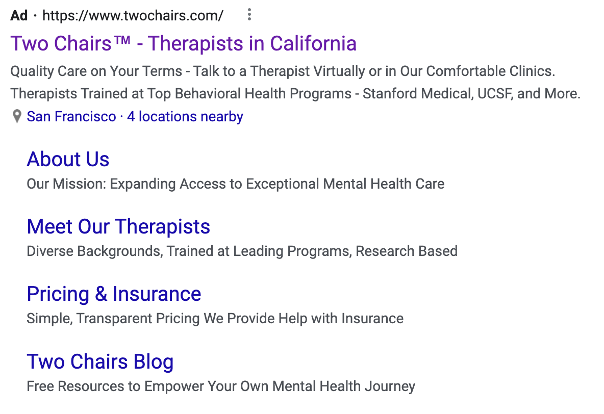

Recent data from Statista reveals more than 80% of U.S. adults use at least one social media site. It follows that running ads and/or sponsored posts on popular social sites is a potentially great way to build awareness, connect with prospects, generate leads, and grow your practice. Social media is also a great channel for promoting a specific specialization like ophthalmology marketing. Establish your ideal personas and objectives and create campaigns accordingly.
Whether your goal is to create brand awareness, drive engagement, generate calls or visits, or all of the above, developing rapport with the community on social media must now be a priority.
According to this in-depth post from Sprout Social, a healthcare practice should use social media in efforts to:
Sprout Social also offers a strong list of ideas to inspire your social media posts:
View this post on Instagram
Form Health often populates their Instagram feed with educational content or events that deliver it. Note their use of #hastags which could increase views.
In a noisy world of media coming at patients from every direction, text messages have become the medium most likely to be seen. Text is now a perfect way to communicate with potential new and existing patients.
Communicate to patients why they’ll want to receive useful information via text and they’ll probably be happy to share their mobile phone numbers. Use text to alert your patients to time-sensitive information, reminders, and more.
Messaging apps are also a good way to create lists for specific communities and maintain engagement. For example, you could create WhatsApp or Facebook Messenger groups and deliver tips and updates regarding nutrition (or any topic).
Capture contact information with lead magnets
It’s not as easy as it once was to get prospects to volunteer to subscribe to email lists.
Lead magnets present a chance to succeed. The goal is to offer something useful in exchange for contact information. Your offer, or “lead magnet,” might be a free consultation, a special offer, an invitation to an event or workshop, timely research, inclusion in a patient group of some sort, or valuable reading material covering relevant health issues.
Email marketing is a cost-effective way to maintain communication, deliver important information, automate appointment reminders, and engage patients.
Your email marketing might include newsletters, welcome emails, webinar invitations, birthday wishes, season’s greetings, and opportunities to connect via other channels. Marketing automation makes it easy to segment email lists and send personalized, relevant, and timely email.
The key to executing nearly every strategy in this lengthy list lies in publishing and sharing content. An informative article from Sprout Social cites a growing phenomenon of self-diagnosis—thanks to “Dr. Google,” which suggests the need for healthcare practices to educate the public. Here are a number of suggestions from the article cited above:
While you’ll share content with patients via all your digital marketing channels, the most important foundation for your healthcare content is your blog—an asset that will reside on your website—giving you complete control over what is published. Your blog will enable you to:
Once you have a website that delivers a great user experience and offers great content, you’ll want to create new landing pages on your website. Landing pages are most effective when they serve as the destination—on your site—from a click you’ve earned from an outside source. They generally focus on a specific service and have a singular objective expressed in a call to action designed to move patients to the next stage of their journey.
Two excellent ideas for landing pages come from a post by High Level Marketing:
In his landmark 1984 book, Influence: The Psychology of Persuasion, Dr. Robert Cialdini, claimed “social proof” was one of the six key principles of persuasion. Briefly defined, social proof is the influence the actions and attitudes of other people have on our own behavior.
In the age of all things digital, the principle has become all-important as a factor for influencing the choices healthcare consumers make. In fact, it’s become a linchpin for what practices often call “reputation management.” Instead of relying on recommendations directly from friends and family, prospective patients now look for ratings and read digital reviews and testimonials.
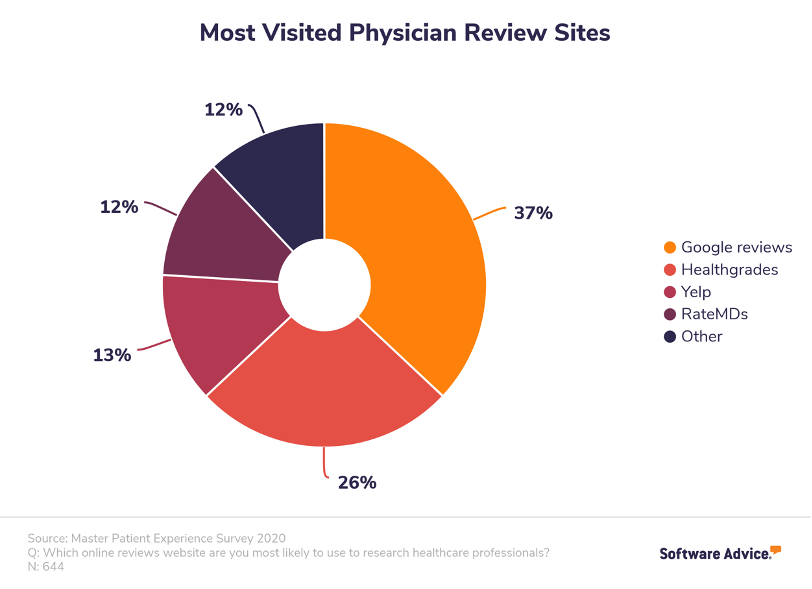
72% of patients use online reviews as their first step in finding a new physician. The data above shows over 75% of them come from Google reviews, Healthgrades, and Yelp.
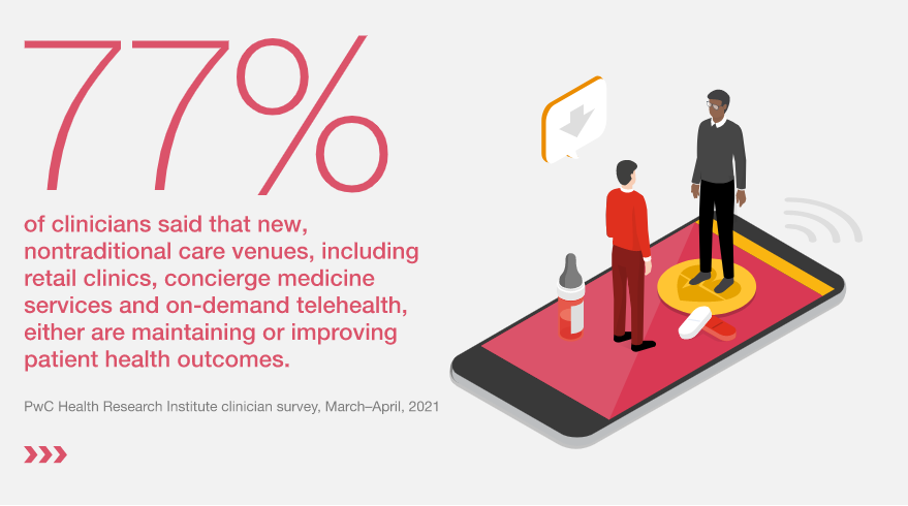
It’s clearly time to offer healthcare consumers more convenient—often, self-serve— solutions. And it’s no secret that technologies including patient portals and mobile apps can be bona fide patient-pleasers.
“Engaging patients in the delivery of health care has the potential to improve health outcomes and patient satisfaction. Patient portals may enhance patient engagement by enabling patients to access their electronic medical records (EMRs) and facilitating secure patient-provider communication.”
Source: National Library of Medicine
Many people prefer to “type” or “tap” to you, rather than call. So, when the goal is to get people to schedule appointments (when is it not?), you’ll want to enable potential patients to book themselves online.
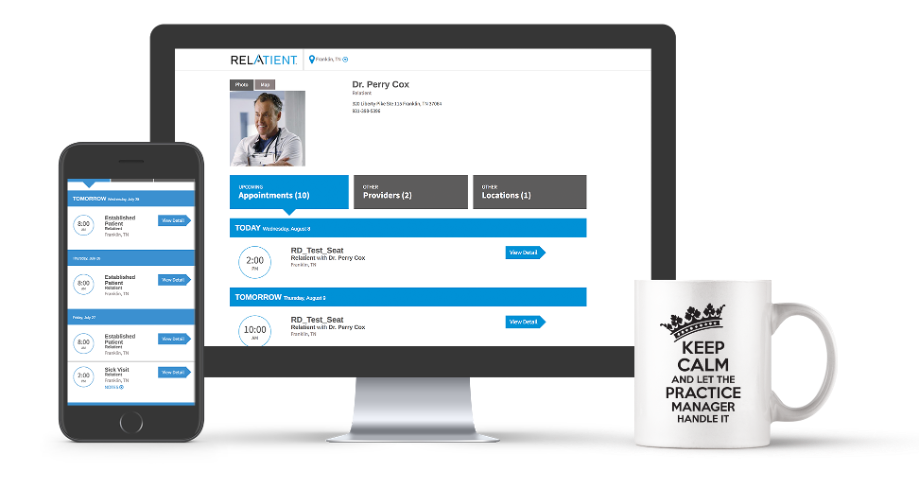
Relatient, a player in the booming patient access space, claims self-scheduling is “quickly becoming the new front door to a physician’s practice” and offers tips for getting started here.
Employee advocacy is the promotion of a brand or company by its employees. Utilizing employee advocacy programs fosters teamwork, and company morale, and enables your practice to amplify its outreach on the cheap.
Compliance laws and regulations have evolved in recent years and will impact your digital marketing. Make absolutely sure to understand and comply with:
HIPAA
HIPAA was enacted to protect patient privacy. The regulation mandates industry-wide standards for the sharing of healthcare information and electronic billing services. All digital marketing content needs to be HIPAA Compliant in the U.S.
GDPR
GDPR law includes 7 principles for the lawful processing of personal data and protects how doctors, hospitals, and marketers can use patient information.
CAN-SPAM
The CAN-SPAM act regulates the information healthcare organizations can deliver via email and provides patients the right to opt-out of receiving email.
While doctors, psychologists and practitioners are—and should be—more concerned with their patients’ well-being than their reputations, PR can loom large for healthcare providers.
At the very minimum, an experienced healthcare public relations firm can help boost your practice by:
Building better, more secure data structures and advancing the use of data for decision making will be paramount to enabling organizations to tackle challenges that range from consumerism to cost management to care deliver.
Source: Huron 2021 Healthcare Executive Research
Sure, effective digital marketing calls for experimenting, but to do it effectively and perpetually improve ROI calls for basing your decisions on data. While your data resides in a variety of places, the following three sources can be essential tools:
With respect to tech adoption, particularly in marketing, healthcare continues to lag.
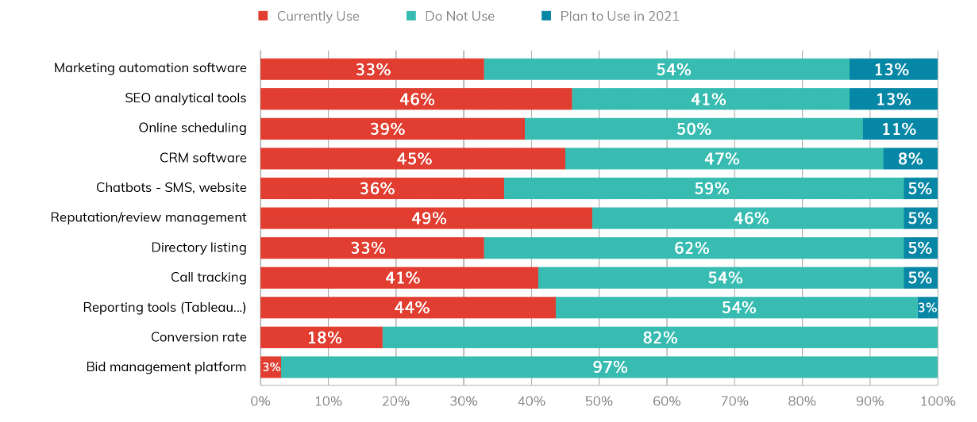
Research from Cardinal Digital Marketing indicates the most significant new marketing tech investments are in marketing automation, SEO analytics, and online scheduling.
Note that while CRM places fourth for new investments, 47% don’t use a customer relationship management solution. They claim many organizations still aren’t ready to integrate CRM with EHR. The time to do so is now.
Here’s what you need to know about integrating HIPAA-compliant CRM with EHR.